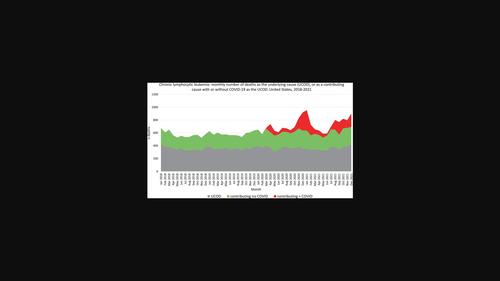当前位置:
X-MOL 学术
›
Int. J. Cancer
›
论文详情
Our official English website, www.x-mol.net, welcomes your feedback! (Note: you will need to create a separate account there.)
Changes in mortality associated with different hematologic malignancies during the pandemic in the United States
International Journal of Cancer ( IF 6.4 ) Pub Date : 2024-02-09 , DOI: 10.1002/ijc.34873 Ugo Fedeli 1 , Claudio Barbiellini Amidei 1 , Xuesong Han 2 , Ahmedin Jemal 2
International Journal of Cancer ( IF 6.4 ) Pub Date : 2024-02-09 , DOI: 10.1002/ijc.34873 Ugo Fedeli 1 , Claudio Barbiellini Amidei 1 , Xuesong Han 2 , Ahmedin Jemal 2
Affiliation

|
Patients with hematologic malignancies are at increased risk of adverse COVID-19 outcomes; nonetheless, only sparse population-based data are available on mortality related to hematologic cancers during the pandemic. Number of deaths and age-standardized mortality rates for specific hematologic malignancies selected either as the underlying cause of death (UCOD), or mentioned in death certificates (multiple causes of death-MCOD) were extracted from the US National Center for Health Statistics, CDC WONDER Online Database. Joinpoint analysis was applied to identify changes in mortality trends from 1999 to 2021, and to estimate the annual percent change with 95% Confidence Intervals (CI) across time segments. Among the most common malignancies, chronic lymphocytic leukemia showed marked peaks in the monthly number of deaths attributed to COVID-19 during epidemic waves; acute myeloid leukemia showed the least variation, and non-Hodgkin lymphoma and multiple myeloma were characterized by an intermediate pattern. Age-standardized death rates relying solely on the UCOD did not show significant variations during pandemic years. By contrast, rates based on MCOD increased by 14.0% (CI, 10.2–17.9%) per year for chronic lymphocytic leukemia, by 5.1% (CI, 3.1–7.2%) for non-Hodgkin lymphoma and by 3.2% (CI, 0.3–6.1%) per year for multiple myeloma. Surveillance of mortality based on MCOD is warranted to accurately measure the impact of the COVID-19 pandemic and of other epidemics, including seasonal flu, on patients with hematologic malignancies, and to assess the effects of vaccination campaigns and other preventive measures.
中文翻译:

美国大流行期间与不同血液系统恶性肿瘤相关的死亡率变化
血液系统恶性肿瘤患者发生 COVID-19 不良结果的风险增加;尽管如此,关于大流行期间与血液癌症相关的死亡率,只有稀疏的基于人群的数据。选择作为根本死因 (UCOD) 或死亡证明中提到的特定血液系统恶性肿瘤的死亡人数和年龄标准化死亡率(多重死因 -MCOD)来自美国国家卫生统计中心 CDC WONDER 在线数据库。应用连接点分析来确定 1999 年至 2021 年死亡率趋势的变化,并估计跨时间段的 95% 置信区间 (CI) 的年度百分比变化。在最常见的恶性肿瘤中,慢性淋巴细胞白血病在流行浪潮期间因 COVID-19 导致的每月死亡人数出现了明显的峰值;急性髓系白血病的变异最小,非霍奇金淋巴瘤和多发性骨髓瘤的特征为中间模式。仅仅依赖 UCOD 的年龄标准化死亡率在大流行年份没有显示出显着变化。相比之下,慢性淋巴细胞白血病基于 MCOD 的发病率每年增加 14.0%(CI,10.2-17.9%),非霍奇金淋巴瘤增加 5.1%(CI,3.1-7.2%),每年增加 3.2%(CI,0.3)。 –6.1%)每年用于多发性骨髓瘤。基于 MCOD 的死亡率监测有必要准确衡量 COVID-19 大流行和其他流行病(包括季节性流感)对血液恶性肿瘤患者的影响,并评估疫苗接种活动和其他预防措施的效果。
更新日期:2024-02-09
中文翻译:

美国大流行期间与不同血液系统恶性肿瘤相关的死亡率变化
血液系统恶性肿瘤患者发生 COVID-19 不良结果的风险增加;尽管如此,关于大流行期间与血液癌症相关的死亡率,只有稀疏的基于人群的数据。选择作为根本死因 (UCOD) 或死亡证明中提到的特定血液系统恶性肿瘤的死亡人数和年龄标准化死亡率(多重死因 -MCOD)来自美国国家卫生统计中心 CDC WONDER 在线数据库。应用连接点分析来确定 1999 年至 2021 年死亡率趋势的变化,并估计跨时间段的 95% 置信区间 (CI) 的年度百分比变化。在最常见的恶性肿瘤中,慢性淋巴细胞白血病在流行浪潮期间因 COVID-19 导致的每月死亡人数出现了明显的峰值;急性髓系白血病的变异最小,非霍奇金淋巴瘤和多发性骨髓瘤的特征为中间模式。仅仅依赖 UCOD 的年龄标准化死亡率在大流行年份没有显示出显着变化。相比之下,慢性淋巴细胞白血病基于 MCOD 的发病率每年增加 14.0%(CI,10.2-17.9%),非霍奇金淋巴瘤增加 5.1%(CI,3.1-7.2%),每年增加 3.2%(CI,0.3)。 –6.1%)每年用于多发性骨髓瘤。基于 MCOD 的死亡率监测有必要准确衡量 COVID-19 大流行和其他流行病(包括季节性流感)对血液恶性肿瘤患者的影响,并评估疫苗接种活动和其他预防措施的效果。



























 京公网安备 11010802027423号
京公网安备 11010802027423号